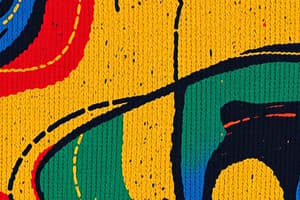Podcast
Questions and Answers
What is Mohair made from?
What is Mohair made from?
- The skin of the Angora rabbit
- The hair of the Angora goat (correct)
- The hair of the Vicuna
- The hair of the Alpaca
Which animal is a wild relative of the llama and found in South America?
Which animal is a wild relative of the llama and found in South America?
- Alpaca
- Angora goat
- Vicuna (correct)
- Yak
Which of the following is true about the production of fur?
Which of the following is true about the production of fur?
- It leaves the hair on the processed skin, resulting in the use of the animal's hide. (correct)
- It involves the removal of skin from the hide without killing the animal.
- The animal is not killed during the fur processing.
- It is primarily a by-product of the dairy industry.
What is the environmental concern associated with cotton production?
What is the environmental concern associated with cotton production?
Which plant is linen made from?
Which plant is linen made from?
What is a common characteristic of organic cotton production?
What is a common characteristic of organic cotton production?
What type of skin is considered a by-product of the food industry?
What type of skin is considered a by-product of the food industry?
Which animal is known for its shaggy hair and humped shoulders?
Which animal is known for its shaggy hair and humped shoulders?
What is a significant environmental concern associated with silk production?
What is a significant environmental concern associated with silk production?
Why is organic silk production considered more sustainable?
Why is organic silk production considered more sustainable?
What percentage of the world's silk fabric is produced organically?
What percentage of the world's silk fabric is produced organically?
What is a major issue with cashmere production?
What is a major issue with cashmere production?
How does organic wool farming differ from conventional wool farming?
How does organic wool farming differ from conventional wool farming?
What is the main benefit of regenerated wool?
What is the main benefit of regenerated wool?
What common misconception do consumers have about organic food related to textiles?
What common misconception do consumers have about organic food related to textiles?
What is a critical aspect of animal welfare in the context of textile production?
What is a critical aspect of animal welfare in the context of textile production?
Flashcards are hidden until you start studying
Study Notes
Sustainability in Fabrics and Yarns
- Positive and negative aspects exist in fabric production, particularly regarding animal and plant fibers.
Natural Animal Fibres - Protein Based
-
Silk:
- Extracted from the cocoon of the Mulberry silk moth, requires intense heat.
- High carbon and water footprint due to water usage and synthetic chemicals in Mulberry cultivation.
- Producing 1 kg of silk demands 3,000 silkworms and 104 kg of Mulberry leaves.
- Organic silk uses fewer chemicals, allowing silkworms to emerge naturally, though production is limited (less than 0.2% of total silk).
-
Wool:
- Obtained by shearing sheep, creating a need for extensive land use.
- Annually, 2 million tonnes are produced; 60% is used for apparel despite wool’s small market share (3%).
- Organic wool lowers production scale, focuses on animal care, and aligns with trends in organic food.
-
Cashmere:
- Sourced from Kashmir goats, overgrazing leads to land degradation and dust clouds.
-
Other Animal Fibres:
- Angora: Produced from Angora rabbits/goats.
- Mohair: Comes from Angora goats.
- Vicuna and Alpaca: Relatives of llamas, with Vicuna being wild and Alpaca domesticated.
- Yak: Large domesticated wild ox with long hair.
- Responsible production methods protect vegetation, promoting ethical animal keeping.
Animal Welfare and Environmental Impact
- Animal caring practices and ethical considerations are crucial in fiber sourcing.
- Fur: Involves killing animals, raising ethical concerns. Faux fur poses different environmental threats.
- Leather/Skin: Derived from animal hides; involves killing. Faux leather can also be environmentally detrimental when made from petroleum.
Fish Skin
- Sourced as a by-product of the fish industry; one tonne of fish fillets yields about 40 kg of fish skin.
Natural Plant Fibres - Cellulose Based
-
Cotton:
- A water-intensive crop that heavily depends on synthetic pesticides and fertilizers, depleting water resources.
- Comprises 26% of global fabric production, with only 1% being organic.
-
Organic Cotton:
- Grown using natural pesticides and practices like companion planting and crop rotation to enhance soil nutrients.
-
Linen:
- Derived from flax fibers, labor-intensive to produce but recognized for strength and absorbency.
- Quality largely influenced by cultivation methods; longer fibers obtained through hand-harvesting or precise cutting techniques.
-
Organic Linen:
- Similar organic practices as cotton, emphasizing sustainable growth and harvesting methods.
Studying That Suits You
Use AI to generate personalized quizzes and flashcards to suit your learning preferences.





